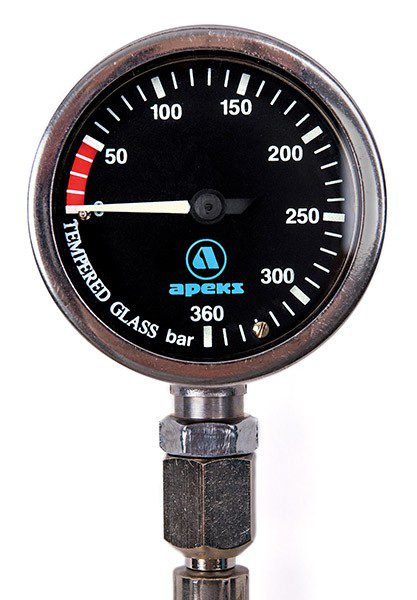After a career spanning more than 30 years as a professional firefighter, Iâm only too aware of how important it is to know how much gas is available to breathe from a cylinder.
For the emergency services itâs one of the most risk-critical aspects when wearing open-circuit breathing apparatus in toxic, hostile environments.
Running out of gas isn’t just stupid but is likely to prove fatal. That said, it’s also one of the easiest things to avoid – all you need to do is check your contents gauge at short, regular intervals.
I’ve trawled through the DIVER Test archives but couldnâ’t find a single review of a submersible pressure gauge, or SPG, which surprised me. So I decided to put a high-end, standalone analogue instrument through the test workshop.

The Design
The Apeks TEK Gauge has a black face to help reduce glare and to preserve night vision in low-light environments. The numerals, intermediate markers and the single hand have a luminescent coating and glow when charged from a light source (usually a dive-torch).
The unit has a chrome-plated marine brass body with a tempered glass face. Its 52mm-diameter scale reads from 0-360 bar with a maximum working pressure of 300 bar, and weighed in at 200grm (without a hose) on my digital scale.
The instrument’s sealed and waterproof body houses a common Bourdon tube mechanism. This works on the principle that a curled-up metal tube tends to straighten when internal pressure is applied, causing the tip to move; the movement of the tip drives the hand via a geared mechanical linkage to indicate a reading against a fixed scale.
For safety reasons the back of the body has a blow-out disc that’s designed to fail and release internal pressure should the Bourdon tube rupture, thus preventing the glass face fragmenting outwards.
The gauge was supplied with an 80cm-long high-pressure rubber hose carrying a burst pressure rating of 1500 bar.
The Tests
The first thing I did was test the TEK Gauge for accuracy. This was something I couldn’t do without enlisting the help of a former colleague from the Fire & Rescue Service Breathing Apparatus Section.
The Fire Service’s technicians use precise measuring instruments to ensure the accuracy of their own contents gauges. When the TEK Gauge was tested it delivered a result of +/–2 bar, which the technician eloquently described as “a pretty accurate gauge” as he scoffed my blackmail lunch at the local boozer.
I like to mount my SPG using a simple but effective piston-clip that’s cable-tied to the end of the hose. Tec-diving purists will be wincing and firing off emails of condemnation to the Editor, followed by a detailed description of the proper way to do it using doubled-over O-rings or loops of nylon line, but the simple, cheap and nasty cable-tie method has never let me down – well, not as yet.
Under water, the weight of this instrument makes it negatively buoyant, and for that read “stable”. Once it’s clipped off on a well-placed BC D-ring, it’s always where you expect it to be throughout the dive.
This might not sound like a big deal, but when you’re constantly checking the reading (as you should be during a dive) it makes the operation as simple as possible.
The black face enabled the contrasting dial markings and, more importantly, the hand to stand out, so a quick glance is all that’s required to assimilate the information.
A red band between the 50 and zero bar markings enhances awareness, highlighting the fact that the dive should be over at that point, while maintaining a safety margin.
Conclusion
The humble SPG is a crucial instrument, and one that should receive more than a cursory glance (pun intended).
The Apeks TEK Gauge proved to be accurate, and it’s robust construction and well-considered layout keeps it simple and easy to read. It should last a lifetime.
I can’t think of a single negative comment to make, so I’ll finish with the same advice I used to give my trainee firefighters: “Gauge check, gauge check, gauge check, then check again.” One day that procedure might just save your life.
SPECS
PRICES: Gauge only, £61. With 80cm hose £90
MAX WORKING PRESSURE: 300 bar
SCALE: 0-360 bar
SIZE: 52mm diameter
DIAL: Black, luminescent numerals and hand
BODY: Chrome-plated marine-grade brass
WEIGHT: 200g (without hose)
CONTACT: www.apeksdiving.com/uk
DIVER GUIDE 10/10
Appeared in DIVER January 2017
